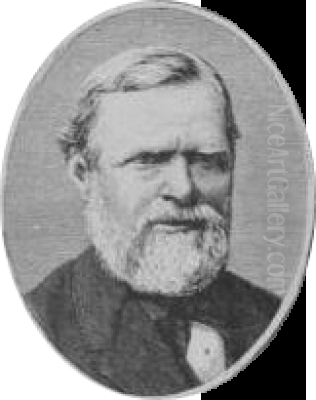
Carl Friedrich Heinrich Werner stands as a significant figure in 19th-century German art, celebrated primarily for his mastery of watercolor and his detailed depictions of architecture and landscapes gleaned from extensive travels. Born in Weimar on October 4, 1808, and passing away in Leipzig on January 10, 1894, Werner's long life spanned a period of immense change in Europe and the wider world, changes reflected in his artistic pursuits and subject matter. His dedication to capturing the world around him with precision and sensitivity, particularly the monuments and atmospheres of Italy and the Near East, secured his place in art history.
Early Life and Artistic Formation
Werner's upbringing provided a foundation in the arts, though not initially in painting. His father was a piano teacher and his mother a singer, immersing him in a creative environment. His initial artistic inclinations led him to study painting in Leipzig under the guidance of Julius Schnorr von Carolsfeld, a prominent painter associated with the Nazarene movement. This early training would have instilled a respect for clear lines and composition.
However, Werner's path took a detour. He developed an interest in architecture, pursuing studies in this field, including a brief period in Munich. This architectural training proved invaluable, honing his eye for structure, form, and spatial representation, skills that would become hallmarks of his later paintings. Despite this diversion, his passion for painting ultimately prevailed. A pivotal moment came after exhibiting architectural drawings in Dresden, which caught the attention of the Academy's director, leading to a crucial scholarship.
The Italian Sojourn: Honing Skills in Watercolor
Around 1831, Werner fully committed himself to painting. The scholarship enabled him to travel to Italy, a destination that had drawn German artists for generations, from Albrecht Dürer to the Romantics and Nazarenes like Friedrich Overbeck and Peter von Cornelius. Werner immersed himself in the Italian artistic environment, spending considerable time in Rome, Florence, Bologna, and notably, Venice.
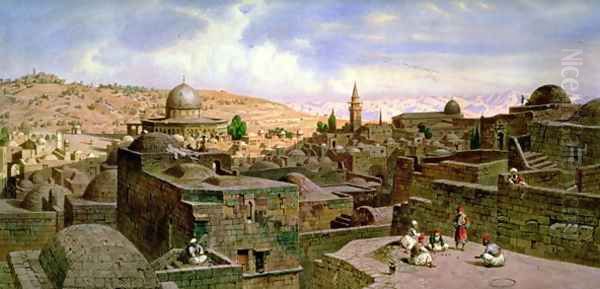
It was in Italy, particularly Venice, that Werner truly found his medium and style. He established a studio in Venice and remained there until the 1850s. The city's unique blend of magnificent architecture, shimmering light, and watery reflections provided endless inspiration. He became exceptionally proficient in watercolor, a medium well-suited for capturing the transient effects of light and atmosphere, yet demanding great technical skill for detailed work. His Italian scenes, often depicting famous landmarks with meticulous accuracy, gained him recognition. He followed in a long tradition of artists captivated by Italy, though his detailed realism differed from the looser, more atmospheric approach of earlier view painters like Canaletto or Francesco Guardi.
Journeys to the Orient: Documenting Distant Lands
Werner's artistic curiosity extended beyond Europe. Like many artists and writers of his time, he was drawn to the perceived exoticism and historical depth of the "Orient." He undertook several significant journeys to the Near East, most notably between 1862 and 1864, traveling through Egypt, Palestine (including Jerusalem, Bethlehem, and Hebron), Syria (including Damascus), and Greece.
These travels were arduous but artistically fruitful. Werner was among the earlier European artists to venture into these regions with the specific aim of documenting their monuments, landscapes, and cultures. He filled sketchbooks with detailed drawings made on site, which formed the basis for larger, highly finished watercolors completed later. His architectural training was particularly beneficial here, allowing him to render complex structures like temples, mosques, and ancient ruins with remarkable precision.
A particularly noteworthy achievement during his time in Jerusalem was gaining permission to paint inside the Dome of the Rock on the Temple Mount. This was an extremely rare privilege for a non-Muslim European artist at the time, highlighting both Werner's diplomatic skill or connections and the unique value of the resulting artworks. These interior views offered Europeans a glimpse into a sacred space few had seen depicted accurately. His dedication mirrored that of other travelling artists like the Scottish painter David Roberts, who also produced stunning architectural views of the region, though Werner often achieved an even greater level of detail in his watercolors.
Artistic Style and Technique
Carl Werner is best known as a watercolorist, although he did produce some oil paintings. His style is characterized by meticulous realism and extraordinary attention to detail. He rendered architectural elements – stone textures, intricate carvings, tile patterns – with painstaking accuracy. This precision likely stemmed from his architectural studies and catered to a 19th-century audience fascinated by historical and topographical accuracy.
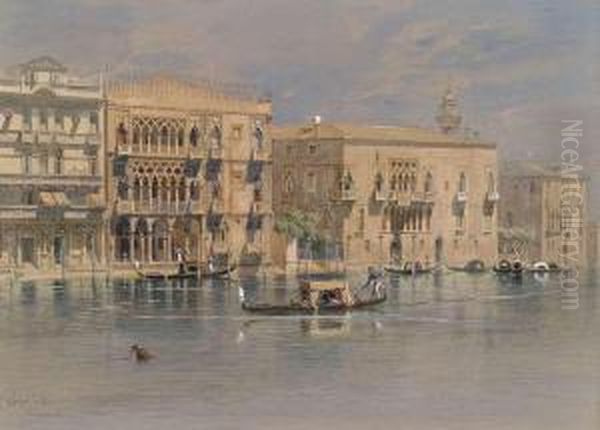
Despite the high level of detail, his works often retain a sense of atmosphere and light. He was adept at capturing the specific quality of light in different locations, whether the bright Mediterranean sun casting sharp shadows in Italy or the softer, more diffused light within ancient Egyptian temples. His use of color was typically rich and nuanced, building up layers of watercolor washes to achieve depth and luminosity. While distinct from the dramatic Romanticism of Caspar David Friedrich or the painterly freedom of Eugène Delacroix's Orientalist scenes, Werner's work offered a compelling, almost documentary, vision. His approach shared a commitment to observed reality found in some Biedermeier artists like Carl Spitzweg, or even the detailed focus, albeit on different subjects, seen in the work of Pre-Raphaelites like John Everett Millais in England.
Many of his compositions were likely developed from sketches made en plein air (outdoors), capturing the immediate impression of a place before being elaborated into finished works in the studio. This combination of on-the-spot observation and careful studio execution allowed for both freshness and precision.
Major Works and Publications
Werner's extensive travels and prolific output resulted in several significant works and publications that cemented his reputation. Among his most celebrated achievements are illustrated volumes based on his journeys:
Nilbilder (Nile Sketches/Pictures): Published around 1875 (though based on his 1864 trip), this collection presented a series of watercolors depicting scenes along the Nile River in Egypt. It included views of famous temples, bustling cityscapes like Cairo, mosques, and the unique landscapes of the region, offering a visual journey for European audiences.
Carl Werner's Jerusalem, Bethlehem und die heiligen Stätten (Jerusalem, Bethlehem, and the Holy Places): Published in 1865, this volume showcased his detailed watercolors of significant sites in the Holy Land, including his unique views from within the Dome of the Rock.
Beyond these publications, specific paintings stand out:
The Dome of the Rock, Jerusalem: His various views, especially the interiors, are among his most famous works due to the rarity of access.
The Lion Court of the Alhambra: Depicting the famous courtyard in Granada, Spain, showcasing his skill with complex Islamic architecture.
The Hall of the Zisa in Palermo: Capturing the grandeur of the Norman palace in Sicily, blending architectural styles.
Venice, Its Zenith and Decline: A subject reflecting the historical consciousness prevalent in the 19th century, likely depicted through Venetian architectural scenes.
These works, characterized by their detail and topographical accuracy, were highly valued not just as art but also as important records of world monuments.
Exhibitions, Recognition, and Teaching
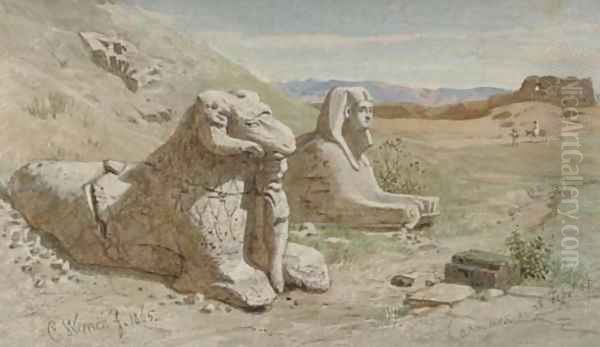
Werner achieved considerable recognition during his lifetime. He exhibited his works widely across Europe. In London, he showed with the prestigious New Watercolour Society (later the Royal Institute of Painters in Water Colours), gaining acceptance in a country with a strong watercolor tradition, home to masters like J.M.W. Turner. He also regularly participated in exhibitions in Germany, including those held by the Berlin Artists' Association, the Berlin Academy, and the Dresden Academy.
His success was reflected in the market; reports mention his works fetching high prices. His reputation extended beyond just exhibiting; he also took on an academic role. Later in his career, Werner served as a professor at the Leipzig Academy of Fine Arts, the same institution where he had once studied. In this capacity, he would have influenced a younger generation of artists, passing on his technical skills and perhaps his passion for detailed observation and travel.
Werner in Context: Contemporaries and the Art World
Werner operated within a vibrant and diverse 19th-century European art scene. His focus on architectural and topographical views placed him in a lineage that included earlier masters but also aligned him with contemporary interests in history, archaeology, and travel. The rise of Orientalism saw many artists, such as Jean-Léon Gérôme and Eugène Delacroix, travel to North Africa and the Near East, though their approaches often emphasized narrative, sensuality, or dramatic effect more than Werner's meticulous documentation. David Roberts is perhaps his closest peer in terms of subject matter and detailed architectural rendering of the Orient.
In Germany, the art world encompassed various trends, from the lingering influence of Romanticism (Caspar David Friedrich) and the Nazarenes (Schnorr von Carolsfeld, Overbeck, Cornelius) to the rise of Realism. Werner's detailed style can be seen as a form of Realism, applied primarily to landscape and architecture rather than the social scenes or historical narratives tackled by contemporaries like Adolph Menzel. While perhaps not as formally innovative as some Impressionists emerging later in the century, Werner excelled within his chosen niche, providing works that appealed to both aesthetic sensibilities and a thirst for knowledge about the wider world. His work also relates to the detailed architectural renderings produced by architects themselves, such as Karl Friedrich Schinkel, though Werner's primary identity remained that of a painter.
There is no specific record of close collaborations or intense rivalries with major named contemporaries like Friedrich, but like all successful artists, he navigated the competitive world of exhibitions and sales, establishing his own distinct reputation.
Legacy and Collections
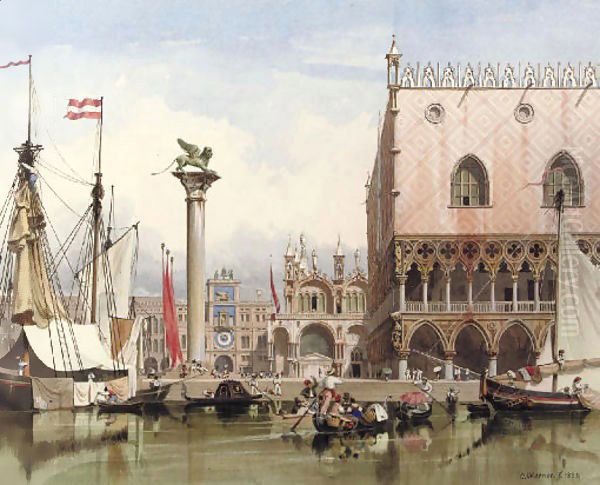
Carl Friedrich Heinrich Werner's legacy rests on his exceptional skill as a watercolorist and his significant contribution to the visual documentation of important architectural sites, particularly in Italy and the Near East. His works provided invaluable records of monuments, some of which have changed or deteriorated since his time. He played a role in shaping European perceptions of these regions through his detailed and widely disseminated images.
His dedication to realism and technical finesse made him one of the foremost practitioners of watercolor in Germany during his era. He demonstrated the medium's capacity for intricate detail and rich coloration, elevating its status.
Today, Werner's works are held in the collections of major museums, including the British Museum in London, the Victoria and Albert Museum, various German institutions like the Leipzig Museum der bildenden Künste (which likely inherited works from the Academy), and potentially museums in Venice. His paintings and prints continue to be appreciated for their artistic merit and historical significance.
Conclusion
Carl Friedrich Heinrich Werner was more than just a painter; he was an artistic traveler, a meticulous observer, and a skilled documenter. From his early training in Leipzig and architectural detour to his formative years in Italy and groundbreaking journeys through the Near East, his career was marked by a dedication to capturing the world with precision and artistry. His mastery of watercolor allowed him to create enduring images of architectural wonders and landscapes, bridging cultures and preserving views of historical sites for posterity. Werner remains an important figure for understanding 19th-century German art, the tradition of topographical watercolor, and the European artistic engagement with Italy and the Orient.